Hydrogen Cyanamide on Citrus: Preliminary Data on Phytotoxicity and Influence on Flush in Potted and Field Trees
Abstract
Bloom in individual citrus (Citrus) trees often continues for more than1 month in south Florida, with even greater bloom duration within most orchard blocks because of variation in bloom timing between trees. Prolonged bloom contributes to variable fruit maturity as harvest approaches and increases severity of postbloom fruit drop (PFD) disease (caused by Colletotrichum acutatum). Hydro-gen cyanamide (cyanamide) has been effective in accelerating bloom in various deciduous fruits, and its potential use in citrus was investigated in this preliminary study. Cyanamide was applied at a range of concentrations, from 0% to 1.0% a.i., to potted trees of six citrus types reflecting fairly broad diversity in commercial citrus that was readily available as seed [alemow (Citrus macrophylla), ‘Duncan’ grapefruit (Citrus paradisi), sour orange (Citrus aurantium), ‘Smooth Flat Seville’ sour orange hybrid (C. aurantium hybrid), ‘Swingle’ citrumelo (C. paradisi X Poncirus trifoliata), and ‘Sun Chu Sha’ mandarin (Citrus reticulata)] in Dec. 1999 while trees were quiescent. Phytotoxicity increased with cyanamide rate, with some damage at 0.125% cyanamide on most tested plants, and large variation among citrus types. All cyanamide rates hastened flushing. Airblast application of cyanamide (0, 0.025%, 0.05%, and 0.10%) was made to mature trees of ‘Valencia’ and ‘Navel’ sweet orange (Citrus sinensis) in Ft. Pierce, FL, on 27 Jan. 2000. On 15 Feb. and 28 Feb. additional trees received cyanamide at 0.05%. There was considerable defoliation, which increased linearly with cyanamide rate. Flushing and flowering were unaffected by cyanamide compared with controls except in February where cyanamide applied at 0.05% increased flowers per tree in ‘Valencia’ sweet orange, and in contrast, 0.1% cyanamide on 27 Jan. reduced ‘Navel’ sweet orange flowering. Cyanamide application to ‘Valencia’ sweet orange on 28 Feb., after initial floweringbut16 days before peak bloom, significantly reduced yield per tree but there were no other effects on cropping. In these trials, cyanamide was not an effective agent for hastening bloom in south Florida citrus with applications late January through February. Further work is needed to determine whether December applications of cyanamide to trees in the field may be more effective in concentrating subsequent flush and bloom

